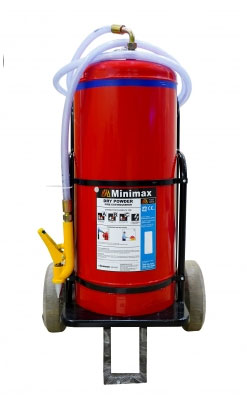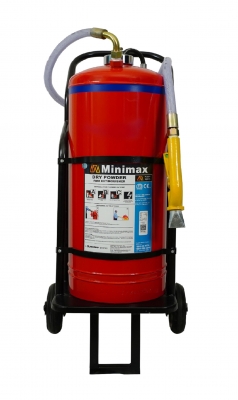ABC Dry Powder Mobile Type

| Specifications | 25 kg | 50 kg | 75 kg |
| Fire Rating - MAP 50 | 20A 233B | 20A 233B | 20A 233B |
| Fire Rating - MAP 90 | 20A 233B | 20A 233B | 20A 233B |
| Working Temperature °C | -30 °C to + 55 °C | ||
| Effective Discharge | Minimum 85% | ||
| Burst Pressure | 55/80 bar min., 110 bar (actual) approx | ||
| Cylinder Testing Pressure | 35 bar for 30 sec. | ||
| Jet Length | 6 mtr. | 8 mtr. | 10 mtr. |
| Min. Effective Discharge Time | 30 sec. | 45 sec. | 60 sec. |
| External CO2 Cylinder | 1 Kg | 2 Kg | |
| Charge | ABC Dry Powder (MAP50 / MAP90) | ||
Minimax ABC Powder Mobile Type extinguishers are preferred where the fire extinguishers are deployed in severe conditions - usually outdoor. They are preferred in industrial applications and enable quick and simple refilling after discharge.
ABC Powder is most versatile type of firefighting equipment, dry powder fire extinguishers are the most popular choice because of their capability for protection against light, ordinary and high Hazards. ABC dry chemical powder fire extinguishers are suitable for use on Class A (ordinary solids), Class B fires (flammable liquids) and Class C (gas and vapors) fires. Dry powder fire extinguishers carry a blue colour band which is clear and easy to see in the event of any emergency.
Dry powder pressure fire extinguishers filled with silicon coated mono ammonium phosphate dry chemical powder with MAP 50% or MAP 90% as per standard requirements.
Look For More
FAQ's
- Class A, B and C Fire Hazard – Fire Extinguisher within 15 m travel distance.
- Class D, F and Special Fire Hazard – Fire extinguisher within 10 m travel distance.






